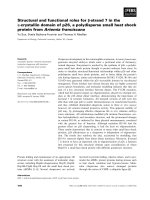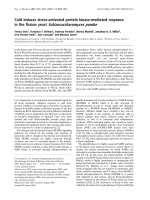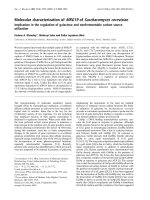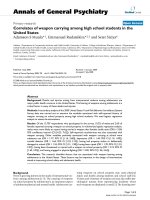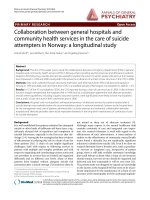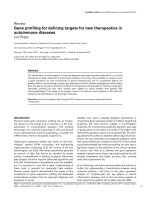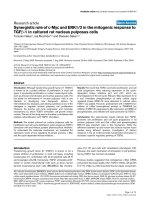Báo cáo y học: "Celecoxib accelerates functional recovery after sciatic nerve crush in the rat" potx
Bạn đang xem bản rút gọn của tài liệu. Xem và tải ngay bản đầy đủ của tài liệu tại đây (208.23 KB, 4 trang )
BioMed Central
Page 1 of 4
(page number not for citation purposes)
Journal of Brachial Plexus and
Peripheral Nerve Injury
Open Access
Short report
Celecoxib accelerates functional recovery after sciatic nerve crush
in the rat
Carlos R Cámara-Lemarroy*, Francisco J Guzmán-de la Garza,
Ernesto A Barrera-Oranday, Andrés J Cabello-García, Armando García-Tamez
and Nancy E Fernández-Garza
Address: Department of Physiology, Universidad Autonoma de Nuevo Leon, School of Medicine, Av. Francisco I. Madero y Dr. Eduardo Aguirre
Pequeño S/N.o, Col. Mitras Centro, 64460, Monterrey, Nuevo Leon, Mexico
Email: Carlos R Cámara-Lemarroy* - ; Francisco J Guzmán-de la Garza - ;
Ernesto A Barrera-Oranday - ; Andrés J Cabello-García - ; Armando García-
Tamez - ; Nancy E Fernández-Garza -
* Corresponding author
Abstract
The inflammatory response appears to be essential in the modulation of the degeneration and
regeneration process after peripheral nerve injury. In injured nerves, cyclooxygenase-2 (COX-2) is
strongly upregulated around the injury site, possibly playing a role in the regulation of the
inflammatory response. In this study we investigated the effect of celecoxib, a COX-2 inhibitor, on
functional recovery after sciatic nerve crush in rats. Unilateral sciatic nerve crush injury was
performed on 10 male Wistar rats. Animals on the experimental group (n = 5) received celecoxib
(10 mg/kg ip) immediately before the crush injury and daily for 7 days after the injury. Control
group (n = 5) received normal saline at equal regimen. A sham group (n = 5), where sciatic nerve
was exposed but not crushed, was also evaluated. Functional recovery was then assessed by
calculating the sciatic functional index (SFI) on days 0,1,7,14 and 21 in all groups, and registering the
day of motor and walking onset. In comparison with control group, celecoxib treatment
(experimental group) had significant beneficial effects on SFI, with a significantly better score on day
7. Anti-inflammatory drug celecoxib should be considered in the treatment of peripheral nerve
injuries, but further studies are needed to explain the mechanism of its neuroprotective effects.
Findings
After injury to peripheral nerves, a sequential pattern of
axonal degeneration and myelin degradation, followed by
rapid regeneration, is initiated [1]. The inflammatory
process and its mediators have been implicated in the reg-
ulation of both the axonal degenerative and regenerative
processes after injury [2,3]. One of the inflammatory
mediators that might play an important role during these
processes is the enzyme cyclooxygenase-2 (COX-2),
responsible for metabolizing cell membrane arachidonic
acid into prostaglandins, among other pro-inflammatory
effects [4].
COX-2 is upregulated and prostaglandin production
increased in macrophages and Schwann cells, after vari-
ous types of peripheral nerve injury [5,6]. Studies on the
upregulation of COX-2 during axonal regeneration have
mainly concentrated on its participation in the induction
Published: 26 November 2008
Journal of Brachial Plexus and Peripheral Nerve Injury 2008, 3:25 doi:10.1186/1749-7221-3-25
Received: 20 August 2008
Accepted: 26 November 2008
This article is available from: />© 2008 Cámara-Lemarroy et al; licensee BioMed Central Ltd.
This is an Open Access article distributed under the terms of the Creative Commons Attribution License ( />),
which permits unrestricted use, distribution, and reproduction in any medium, provided the original work is properly cited.
Journal of Brachial Plexus and Peripheral Nerve Injury 2008, 3:25 />Page 2 of 4
(page number not for citation purposes)
of neuropathic pain, instead of on the regeneration proc-
ess itself [7]. However, the fact that COX-2 is so strongly
upregulated after nerve injury, and also able to modulate
inflammatory mediators such as pro-inflammatory
cytokines, suggest an important role for this enzyme in the
evolution of nerve regeneration as well [8].
Celecoxib (CLX) is a selective COX-2 inhibitor with
potent anti-inflammatory and analgesic properties [9].
CLX has shown neuroprotective properties in models of
cerebral ischemia and experimental inflammatory neuritis
[10,11]. The use of CLX has also been shown to be effec-
tive in reducing neuropathic pain following peripheral
nerve injury in rats [7]. A recent study found that acetyl
salicylic acid, a non-selective COX inhibitor, could accel-
erate functional recovery after a nerve crush lesion in the
rat, although other mechanisms of action were believed to
be involved [12]. However, the effects of CLX on func-
tional recovery after peripheral nerve injury, to the best of
our knowledge, have not been studied before. In this
study we investigated the effects of CLX on functional
recovery following peripheral nerve injury using a rat sci-
atic nerve crush model.
Animal procedures were performed in accordance with
the proper use and care of laboratory animals. In this
study15 male Wistar rats (250–300 g) were used. The ani-
mals were kept in a temperature controlled room, on a 12-
hour light/dark cycle, with access to food and water ad libi-
tum.
The animals were randomly assigned into 3 different
groups: Experimental (n = 5), Control (n = 5) and Sham
group (n = 5). In experimental and control groups, unilat-
eral sciatic nerve crush was done as follows: After anesthe-
sia with pentobarbital (Anestesal, Pfizer Inc, Mexico) (50
mg/kg ip), a small incision is made in the upper tight, and
muscles are separated in order to expose the sciatic nerve.
The nerves are then crushed with a 1 mm wide non-ser-
rated hemostatic clamp at a standardized force at mid-
tight level for 30 seconds. In sham group the sciatic nerve
was exposed but not crushed. Afterwards muscle and skin
are sutured separately, and the animal left to recuperate in
individual cages. This crush injury can be used as a model
of axonotmesis to study nerve function recovery [13].
Animals in the experimental group received CLX (Cele-
brex
®
, Pfizer Inc, Mexico) (10 mg/kg ip) immediately
before and daily for 7 days after the injury. Control group
received normal saline at the same time periods.
Evaluation of the sciatic functional index (SFI), a reliable
assessment of nerve recovery [14], was carried out in all
animals in days 0 (before surgery) and on days 1, 7, 14
and 21 after surgery. The hind feet of the rats was marked
with water soluble black ink, and then the animal was
allowed to walk freely across a 12 cm wide and 50 cm long
confined walkway leaving its foot prints on a white piece
of paper covering the walkway floor. The distance from
the heel to tip of the third toe and both the toe-spread and
intermediary toe-spread, defined as the distance between
the first and fifth, and between the second and fourth toe,
respectively, was measured to the nearest 0.5 mm. Both
normal and injured limbs were evaluated. We measured 3
footprints per limb per animal were and then averaged the
values in order to calculate the SFI for each animal, using
a formula described elsewhere [15]. An SFI nearing 100
indicates severe impairment whereas an SFI nearing 0 is
considered normal.
Functional recovery was also examined by registering the
day of motor and walking onset in all animals as
described by Gold et al [16]. Two blinded observers exam-
ine recovery daily, and register the number of days that
each animal takes in order to be able to right the foot and
move its toes (motor onset), and to walk using the foot
and toes of the injured hindlimb (walking onset). The val-
ues are then averaged in order to calculate the mean for
each group, and compared.
Changes in SFI over time were compared between groups
using a 2-way repeated measures analysis of variance
(ANOVA). When the ANOVA showed significant differ-
ence between groups, we applied a Tukey post hoc test to
find the location of the difference. One-way ANOVA was
used to compare motor and walking onset between con-
trol and experimental group. Data were analyzed with
SPSS 11.0 (SPSS Inc. Software, Chicago, Illinois, USA) sta-
tistical software, and all values are expressed as mean +/-
SD and P < 0.05 was considered statistically significant.
Before surgery, all animals had SFI values nearing 0 (nor-
mal), and immediately after nerve crush values above 90
(severely impaired), with no statistical difference between
groups. Thereafter, starting from day 1 and until the last
day of the study, rats in the experimental group showed
significantly faster recovery compared with the control
group (P = 0.02, between subjects repeated measures
ANOVA), with post hoc tests showing a significant differ-
ence on day 7 (80.2 +/- 6.3 vs. 66 +/- 12.1; P = 0.04) The
motor and walking day onset was reached earlier in rats in
the experimental group compared with control group,
being statistically significant only for motor onset (11.4 +/
- 1.1 vs. 13.6 +/- 1.8). The Sham group had normal SFI val-
ues throughout the study (table 1).
Our results show that CLX can accelerate functional recov-
ery following sciatic nerve crush in the rat. However, our
small sample size and large SD are statistical weaknesses
of our study, and the absence of histological or electro-
Journal of Brachial Plexus and Peripheral Nerve Injury 2008, 3:25 />Page 3 of 4
(page number not for citation purposes)
physiological evidence prevents us of concluding that CLX
has similar effects over axonal regeneration. COX-2 has
been shown to modulate neuroinflammation in various
neurological disorders [17] and pro-inflammatory
cytokines have been implicated in the orchestration of the
inflammatory process that lead to degeneration and
regeneration after nerve injury [18]. One of these
cytokines, Tumor necrosis factor alpha (TNF-alpha), is
known to induce nuclear factor kappab (NF-kappab) acti-
vation, a transcription factor that promotes further pro-
inflammatory cytokine production in inflammatory cells
[19]. Recent evidence has shown that CLX can inhibit
TNF-alpha dependent activation of NF-kappaB, resulting
in strong anti-inflammatory activity [20]. Macrophages
and Schwann cells also play essential roles in axonal
degeneration and regeneration in injured peripheral
nerves [21] and COX-2 is upregulated in both of these
cells during peripheral nerve inflammation [22]. Addi-
tionally, COX-2 inhibition has been shown to inhibit
macrophage and glial cell neurotoxic activity in neurons
in vitro [23]. Whether one of these effects is the mecha-
nism responsible for the results of our study requires fur-
ther investigations. Nevertheless, our results suggest that
CLX can beneficially alter the course of functional recov-
ery after peripheral nerve injury.
Abbreviations
COX-2: cyclooxygenase-2; SFI: sciatic functional index;
CLX: celecoxib; TNF-alpha: tumour necrosis factor alpha;
NF-kappaB: nuclear factor kappa b; SD: standard devia-
tion.
Competing interests
The authors declare that they have no competing interests.
Authors' contributions
CRCL designed the study, performed research, and wrote
the manuscript. FJGG helped design research and ana-
lyzed the data. EABO helped design the study and perform
research. AJCG carried out the behavioral studies on the
animals. AGT carried out the behavioral studies on the
animals. NEFG analyzed data and revised the manuscript.
All authors read and approved the manuscript.
Acknowledgements
We would like to thank MVZ José Luis Vázquez Juárez for providing and
ensuring the care of laboratory animals.
References
1. Stoll G, Müller HW: Nerve injury, axonal degeneration and
neural regeneration: basic insights. Brain Pathol 1999,
9(2):313-25.
2. Richardson PM, Lu X: Inflammation and axonal regeneration. J
Neurol 1994, 242(Suppl 1):S57-60.
3. Hirschberg DL, Yoles E, Belkin M, Schwartz M: Inflammation after
axonal injury has conflicting consequences for recovery of
function: rescue of spared axons is impaired but regenera-
tion is supported. J Neuroimmunol 1994, 50(1):9-16.
4. Parente L, Perretti M: Advances in the pathophysiology of con-
stitutive and inducible cyclooxygenases: two enzymes in the
spotlight. Biochem Pharmacol 2003, 65:153-9.
5. Muja N, DeVries GH: Prostaglandin E(2) and 6-keto-prostag-
landin F(1alpha) production is elevated following traumatic
injury to sciatic nerve. Glia 2004, 46(2):116-29.
6. Takahashi M, Kawaguchi M, Shimada K, Konishi N, Furuya H,
Nakashima T: Cyclooxygenase-2 expression in Schwann cells
and macrophages in the sciatic nerve after single spinal
nerve injury in rats. Neurosci Lett 2004, 17, 363(3):203-6.
7. Ma W, Eisenach JC: Morphological and pharmacological evi-
dence for the role of peripheral prostaglandins in the patho-
genesis of neuropathic pain. Eur J Neurosci 2002, 15(6):1037-47.
8. Ma W, Eisenach JC: Cyclooxygenase 2 in infiltrating inflamma-
tory cells in injured nerve is universally up-regulated follow-
ing various types of peripheral nerve injury. Neuroscience 2003,
121(3):691-704.
9. Brune K, Hinz B: Selective cyclooxygenase-2 inhibitors: simi-
larities and differences. Scand J Rheumatol 2004, 33(1):1-6.
10. Miyamoto K, Oka N, Kawasaki T, Miyake S, Yamamura T, Akiguchi I:
New cyclooxygenase-2 inhibitors for treatment of experi-
mental autoimmune neuritis. Muscle Nerve 2002, 25(2):280-2.
11. Sinn DI, Lee ST, Chu K, Jung KH, Song EC, Kim JM, Park DK, Kim M,
Roh JK: Combined neuroprotective effects of celecoxib and
memantine in experimental intracerebral hemorrhage.
Neu-
rosci Lett 2007, 16, 411(3):238-242.
12. Subbanna PK, Prasanna CG, Gunale BK, Tyagi MG: Acetyl salicylic
acid augments functional recovery following sciatic nerve
crush in mice. J Brachial Plex Peripher Nerve Inj 2007, 2:3.
13. Bridge PM, Ball DJ, Mackinnon SE, Nakao Y, Brandt K, Hunter DA,
Hertl C: Nerve crush injuries – a model for axonotmesis. Exp
Neurol 1994, 127(2):284-90.
14. Hare GM, Evans PJ, Mackinnon SE, Best TJ, Bain JR, Szalai JP, Hunte
DA: Walking track analysis: a long-term assessment of
peripheral nerve recovery. Plast Reconstr Surg 1992, 89:251-258.
15. Carlton JM, Goldberg NH: Quantitating integrated muscle func-
tion following reinnervation. Surg Forum 1986, 37:611-2.
16. Gold BG, Storm-Dickerson T, Austin DR: The immunosuppres-
sant FK506 increases functional recovery and nerve regener-
Table 1: Motor functional recovery after sciatic nerve crush
Groups (n = 5 each) SFI day 0 SFI day 1 SFI day 7 SFI day 14 SFI day 21 Motor Onset (days) Walking Onset(days)
Control (saline) -3.15 +/- 6.38 84.5 +/-11.8 80.2 +/- 6.3 59 +/- 10.2 27.5 +/-6.3 13.6 +/- 1.5 14.6 +/- 1.8
ExperimentalCelecoxib 10
mg/kg/day
0.83 +/- 6.64 77.9 +/- 3.3 * 66 +/- 12.1 52.4 +/- 8.3 16.1 +/-14.3 *11.4 +/- 1.1 12.8 +/- 1.3
Sham 0.14 +/- 5.88 3 +/- 3.7 -0.3 +/- 6.1 2.4 +/- 5.7 1 +/- 5.7 1 1
* indicates significant difference from control (P < 0.05)
All values are expressed as mean +/- SD.
Publish with BioMed Central and every
scientist can read your work free of charge
"BioMed Central will be the most significant development for
disseminating the results of biomedical research in our lifetime."
Sir Paul Nurse, Cancer Research UK
Your research papers will be:
available free of charge to the entire biomedical community
peer reviewed and published immediately upon acceptance
cited in PubMed and archived on PubMed Central
yours — you keep the copyright
Submit your manuscript here:
/>BioMedcentral
Journal of Brachial Plexus and Peripheral Nerve Injury 2008, 3:25 />Page 4 of 4
(page number not for citation purposes)
ation following peripheral nerve injury. Restor. Neurol. Neurosci
1994, 6:287-296.
17. Tzeng SF, Hsiao HY, Mak OT: Prostaglandins and cyclooxygen-
ases in glial cells during brain inflammation. Curr Drug Targets
Inflamm Allergy 2005, 4(3):335-40.
18. Shamash S, Reichert F, Rotshenker S: The cytokine network of
Wallerian degeneration: tumor necrosis factor-alpha, inter-
leukin-1alpha, and interleukin-1beta. J Neurosci 2002,
22(8):3052-3060.
19. Li H, Lin X: Positive and negative signaling components
involved in TNFalpha-induced NF-kappaB activation.
Cytokine 2008, 41(1):1-8.
20. Funakoshi-Tago M, Shimizu T, Tago K, Nakamura M, Itoh H, Sonoda
Y, Kasahara T: Celecoxib potently inhibits TNFalpha-induced
nuclear translocation and activation of NF-kappaB. Biochem
Pharmacol 2008, 76(5):662-671.
21. Brück W: The role of macrophages in Wallerian degenera-
tion. Brain Pathol 1997, 7(2):741-52.
22. Shin T, Lee Y, Sim KB: Involvement of cyclooxygenase-1 and -2
in the sciatic nerve of rats with experimental autoimmune
neuritis. Immunol Invest 2003, 32(3):123-30.
23. Klegeris A, McGeer PL: Cyclooxygenase and 5-lipoxygenase
inhibitors protect against mononuclear phagocyte neuro-
toxicity. Neurobiol Aging 2002, 23(5):787-94.

